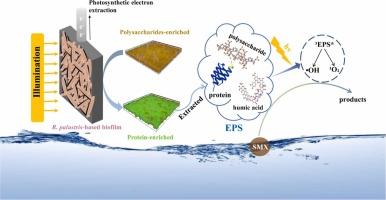电化学增强无氧光养细菌胞外光敏成分的积累:制备水处理用可降解微生物光敏剂的新见解
IF 11.3
1区 环境科学与生态学
Q1 ENGINEERING, ENVIRONMENTAL
引用次数: 0
摘要
胞外聚合物(EPS)是一种很有前途的环境修复生物材料,但其生产效率低,降解污染物能力有限,阻碍了其应用。在本研究中,光合电子提取使palustris Rhodopseudomonas (R. palustris)能够高效地产生富含功能化成分的EPS。由电驯化的palustris生产的增强EPS (0.2V-EPS)在10小时内对磺胺甲异唑(SMX)的降解率达到82%,与开路条件下生产的EPS (OP-EPS)相比提高了18%。机理分析表明,光合电子提取富集了色氨酸、腐植酸、黄腐酸等光敏分子,显著促进了活性物质的产生。鉴定出的主要活性物质是三激发EPS(³EPS)、¹O₂和•OH,其中¹O₂是SMX降解的主要贡献者。与对照相比,³EPS oc、¹O₂和•OH的稳态浓度分别提高了73%、34%和16%。0.2V-EPS的结构修饰,包括亲水性、电负性和芳香性的增强,增强了其物理化学性质,从而促进了与污染物的相互作用。此外,生物膜多糖减少88%,自由基清除活性降低,促进活性物质的产生。该研究为增强EPS功能提供了可持续的策略,并为微生物对污染物降解的代谢调节提供了见解。本文章由计算机程序翻译,如有差异,请以英文原文为准。

Electrochemical enhancement of the accumulation of photosensitive components in Anoxygenic Phototrophic Bacteria extracellular:a new insight into the preparation of degradable microbial photosensitizer for water treatment
Extracellular polymeric substances (EPS) are promising biomaterials for environmental remediation, but their application is hindered by low production efficiency and limited pollutant degradation capacity. In this study, photosynthetic electron extraction enabled Rhodopseudomonas palustris (R. palustris) to efficiently produce EPS enriched with functionalized components. The enhanced EPS (0.2V-EPS), produced from electrically domesticated R. palustris, achieved an 82% degradation rate of sulfamethoxazole (SMX) within 10 hours, an 18% improvement compared to EPS produced under open-circuit conditions (OP-EPS). Mechanistic analysis revealed that photosynthetic electron extraction enriched EPS with photosensitive molecules, including tryptophan, humic acid, fulvic acid, which significantly promoted the generation of reactive species. The primary reactive species identified were triplet-excited EPS (³EPS⁎), ¹O₂, and •OH, with ¹O₂ as the dominant contributor to SMX degradation. The steady-state concentration of ³EPS⁎, ¹O₂, and •OH increased by 73%, 34% and 16%, respectively, compared to the control. Structural modifications of 0.2V-EPS, including increased hydrophilicity, electronegativity, and aromaticity, enhance its physicochemical properties, thereby facilitating interactions with pollutants. Furthermore, an 88% reduction in biofilm polysaccharides diminished free radical scavenging activity, promoting the generation of reactive species. This study provides a sustainable strategy for enhancing EPS functionality and offers insights into the metabolic regulation of microorganisms for pollutant degradation.
求助全文
通过发布文献求助,成功后即可免费获取论文全文。
去求助
来源期刊

Journal of Hazardous Materials
工程技术-工程:环境
CiteScore
25.40
自引率
5.90%
发文量
3059
审稿时长
58 days
期刊介绍:
The Journal of Hazardous Materials serves as a global platform for promoting cutting-edge research in the field of Environmental Science and Engineering. Our publication features a wide range of articles, including full-length research papers, review articles, and perspectives, with the aim of enhancing our understanding of the dangers and risks associated with various materials concerning public health and the environment. It is important to note that the term "environmental contaminants" refers specifically to substances that pose hazardous effects through contamination, while excluding those that do not have such impacts on the environment or human health. Moreover, we emphasize the distinction between wastes and hazardous materials in order to provide further clarity on the scope of the journal. We have a keen interest in exploring specific compounds and microbial agents that have adverse effects on the environment.
 求助内容:
求助内容: 应助结果提醒方式:
应助结果提醒方式:


